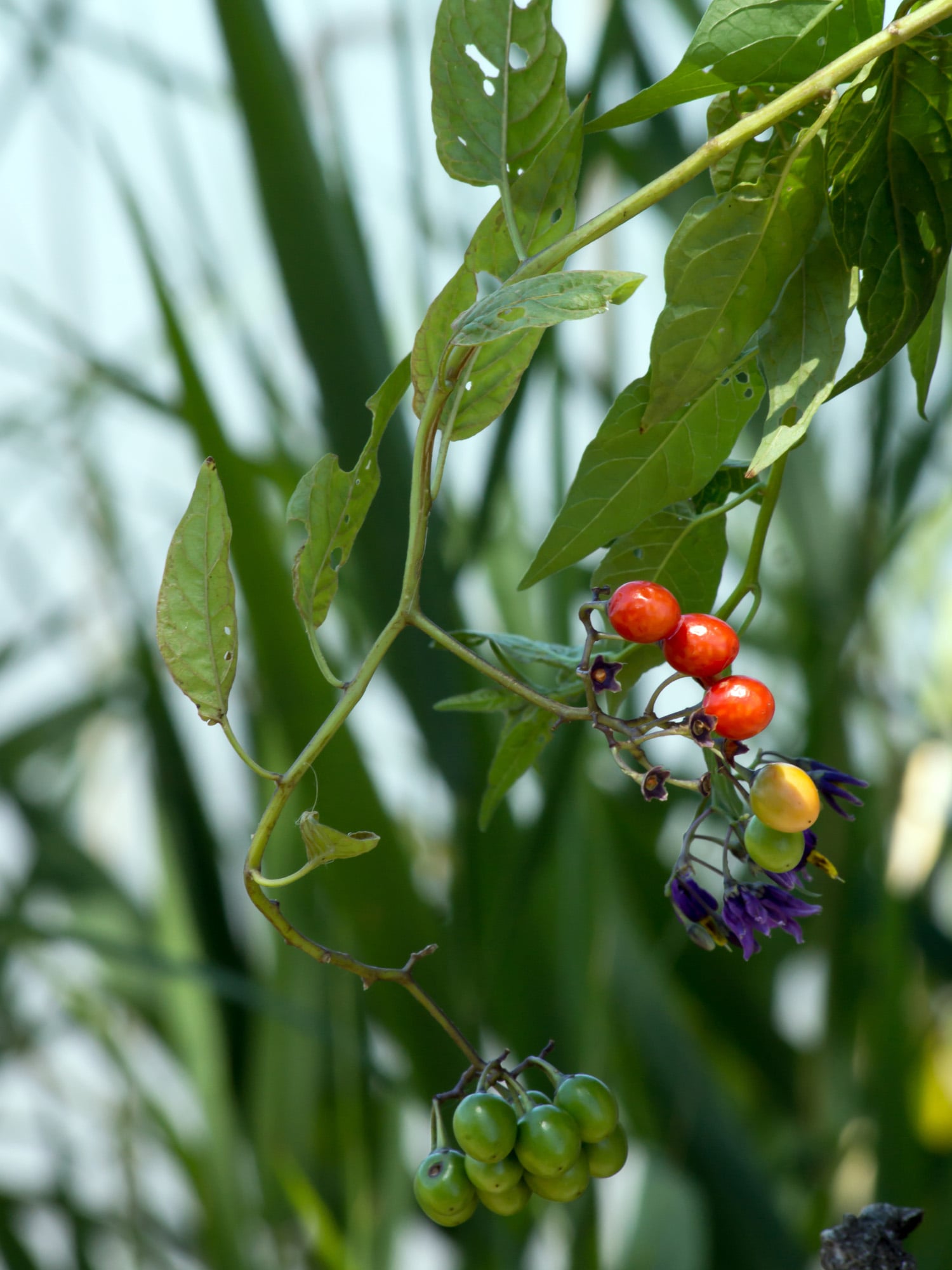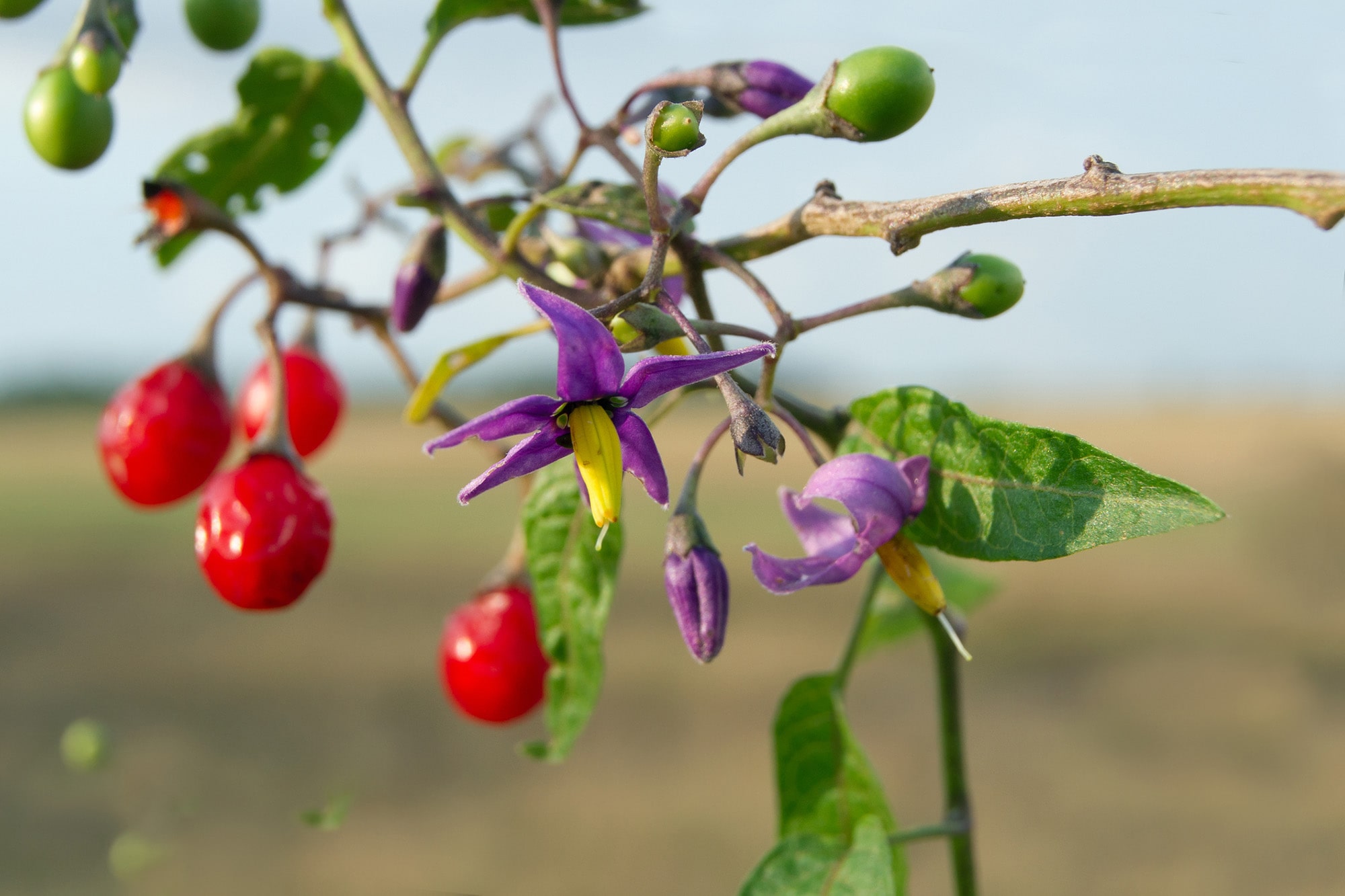Bittersweet Nightshade
Characteristics

Bittersweet nightshade is a member of the nightshade family (Solanaceae), the same family that hosts many of our delicious foods like tomato, potato, and eggplant. The family also includes some very poisonous plants such as belladonna and deadly nightshade. Bittersweet nightshade is toxic to people as well as pets and livestock. Though it has an unpleasant smell that causes most to avoid eating it. Many birds are able to eat the berries and they are the primary way that seeds are spread. Bittersweet nightshade has stereotypical nightshade flowers, with five purple petals that curve back towards the stem and yellow stamens that form a prominent cone. Each flower produces a round or egg-shaped berry that matures from green to orange or red. The leaves are typically a dark green and are arrowhead-shaped; often with two wings at the bottom of each leaf. The plant grows as a perennial vine or semi-woody shrub and the woody sections are white and brittle. Roots grow horizontally just below the soil. The plant spreads by sending up suckers and vines that grow along the ground can root at the nodes. The plant will grow along the ground or will climb up trees or structures such as fences or walls. The branches grow three to six feet each year and often die back in the cooler months. Bittersweet nightshade grows particularly well in moist soils such as in wetlands or along streams.
Why is it here? Why don’t we want it?
Bittersweet nightshade is native to Eurasia and was introduced as an ornamental plant in North America. Although it is very toxic, its roots were historically used for everything from witchcraft to treating bruises. It can be a problem in wetlands. It can out-compete native vegetation and can grow so densely in streams that it disrupts the flow, blocking the passage of fish such as salmon.
What is Oxbow doing about bittersweet nightshade?
Bittersweet nightshade is a common, though not overwhelming, part of our wetlands. We have a reasonable idea of where it is growing at Oxbow and we are monitoring it. It is regularly found growing amongst our meadows with reed canarygrass (Phalaris arundinacea), a highly invasive grass species. Bittersweet nightshade is not particularly widespread or troublesome right now. It is mostly among other weeds and it has not been found in areas that are regularly used by our visitors or farmers. We don’t currently have any plans to manage bittersweet nightshade, other than making sure there are no detrimental effects to newly restored area. So far it hasn’t been too much of an issue. We hope that as we restore our weedy areas, this plant naturally loses whatever footing it has found here.

What you can do about bittersweet nightshade on your property
Bittersweet nightshade is not being monitored by the King County Noxious Weed Control Program. They can provide guidance on how to remove it from your property. They are keeping an eye on this weed, but it’s fairly widespread and only problematic on a site-by-site basis. If you want to get rid of bittersweet nightshade there are various techniques that you can use. Remember that these plants are toxic, so wear gloves and other protective clothing and wash your hands well after working with them. The roots are fairly shallow, but they are also brittle, so pulling it up can be challenging. Any root fragments left in the soil can re-sprout. Because of the way it grows along the ground, this is not an easy plant to mow effectively. But removing as much above and below-ground vegetation you can may be effective. Clear away by hand or with hand tools, and return regularly to remove it as it regrows. You can also use sheet mulching techniques or landscaping fabric to cover patches of bittersweet nightshade. As long as you monitor the edges for any escapees, you should see success within a few years. Because this plant grows in sensitive wetland habitats, there are rules around how much land can be disturbed by digging up this plant. If you have a particularly large patch of bittersweet nightshade in a wetland area or you plan to use herbicides, make sure that you check out the guidelines in the Best Management Practices for bittersweet nightshade. For more information, check out King County Noxious Weeds.
What you can do if you’ve touched, sniffed, or ingested bitttersweet nightshade
If you or someone you see tastes any part of bittersweet nightshade, especially the leaves or berries, call poison control at 1-800-222-1222 or a medical professional and follow their guidance. Symptoms are usually gastrointestinal and include abdominal pain, headaches, vomiting, thirst, difficulty breathing, restlessness, paralysis, dilated pupils, diarrhea, blood in urine, weakness, loss of sensation, and sometimes death. The toxicity of any particular plant varies with its access to nutrients and growth stage. This plant is not dangerous to touch, but do make sure you wash your hands thoroughly if you’ve handled it to avoid ingesting the toxins that remain on your hands.
